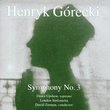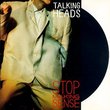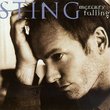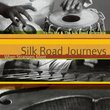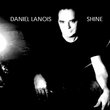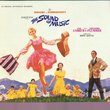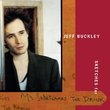| All Artists: Arvo Part, Takuo Yuasa, Ulster Orchestra Title: Arvo Pärt: Tabula Rasa; Symphony No. 3; Collage Members Wishing: 0 Total Copies: 0 Label: Naxos Release Date: 1/16/2001 Genre: Classical Styles: Chamber Music, Forms & Genres, Concertos, Sonatas, Instruments, Reeds & Winds, Symphonies Number of Discs: 1 SwapaCD Credits: 1 UPC: 636943459126 |
Search - Arvo Part, Takuo Yuasa, Ulster Orchestra :: Arvo Pärt: Tabula Rasa; Symphony No. 3; Collage
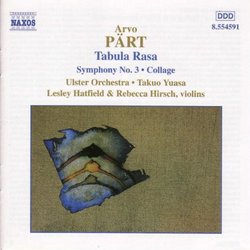 | Arvo Part, Takuo Yuasa, Ulster Orchestra Arvo Pärt: Tabula Rasa; Symphony No. 3; Collage Genre: Classical
Along with Fratres, Tabula Rasa is easily the most popular instrumental composition that Estonian composer Arvo Pärt has ever penned. It's no wonder, either. This swirling double concerto for violins, string section, ... more » |
Larger Image |
CD DetailsSynopsis
Amazon.com Along with Fratres, Tabula Rasa is easily the most popular instrumental composition that Estonian composer Arvo Pärt has ever penned. It's no wonder, either. This swirling double concerto for violins, string section, and piano is crammed with sonic drama, as well as quiet moments, making it the perfect showpiece for the composer's meditative tintinnabuli style of composition. Violinists Leslie Hatfield and Rebecca Hirsch deliver an electrifying performance of this work that easily stands alongside interpretations by Gidon Kremer (to whom this piece was dedicated) and others. Compared with Kremer's recordings, the prepared piano sounds a bit muted here, but this is a minor qualm--the violins and Ulster Orchestra steal the show. Going back in time, Collage uber BACH dates from 1964 and shows us how far Pärt's compositional style has evolved over the decades. Dense string textures give way to brief allusions of Bach, though the piece is thoroughly indebted to serialism. Symphony No. 3 from 1971 is one of the composer's lesser-recorded masterpieces, which is a shame because it shows the composer at a crossroads, incorporating elements of modernism, Gregorian chant, and polyphony. The resulting work sounds epic, gripping, and reflective, but ends with an unexpected last gasp of excitement. Pärt fans won't need much convincing to buy this disc; these are great performances. But every classical CD collection should have at least one disc by the master of "holy minimalism" (and so much more), and this budget-priced disc is just about the perfect introduction to the composer's instrumental works. --Edward Garabedian Similarly Requested CDs
|
CD Reviews5 stars to repertoire/performance, 1 to the sound N. Daniele Pietro | Milano, MI Italy | 01/15/2001 (3 out of 5 stars) "This time Naxos didn't make too happy. This cd is actually the perfect introduction to Part's music, featuring three of the four steps in the evolution of this composer. In the beginning Part was a stark, albeit very individual, serialist ( mercifully, this aspect is not documented here), then he began to introduce neo-classical elements in his music, with Bach' s severe spirituality as a beacon. This second phase ("collage" style) is documented by the masterful "Bach" collage, a piece that, despite the name, does not sound derivative or patchy at all. It's a little suite that somewhat sounds like Baroque, but at the same time sounds unmistakably modern, especially in the 2nd movement, which starts most gently and then starts to... how could I say? .. growl and snarl like a genetic mutation? (listen and you'll understand what I mean, I promise!) In the following phase Part entirely reverted to Neo-Classical manners, but in a sacred/ancient moodmore than baroque. Although clearly transitional, the 3rd sym. is very good, with a distinct Stravinskian flavour. Finally Part concentrated his styles in the current "tintinnabuli" style, here represented by the magisterial "Tabula Rasa". It's a piece in 2 movements, for string orchestra and "prepared" piano (which sounds like bells, hence the "tintinnabuli" word), where all the Part's better known trademarks are present: alternation of music and (expressive) silences, utterly refined string string textures, a rarefied spirituality and, above all, a sense of timelessness. I know some find it too "minimal" (i.e. boring), I think it's just music that requires a degree of emotional consonance. All the 3 pieces actually receive strong performances here: the Ulster Orchestra does not sound at all like a "regional" ensemble ( beatifully rich and disciplined strings) and their conductor is clearly attuned to the music's idiom. The problem is the recording: while warm and well-detailed, the sound is also excruciatingly hissy, in a way that actually reminded me of analog recordings, even if it's DDD. Weird, and too bad, since this is exactly the kind of music that needs digital silence and, unfortunately, the piece with the loudest hiss is just Tabula Rasa! Altogether a very good&cheap introductory issue if you want to know what Part is about, but if first-class sound is one of your priorities you should switch (like I did ) to the 20/21 Neeme Jarvi (a longtime Part advocate) disc. It has the same items, but it's played even better (one of the soloists is Gil Shaham!) and infinitely better recorded." Interesting piece in uncompetitive performance and recording Christopher Culver | 12/06/2004 (1 out of 5 stars) "This Naxos disc contains three works of Arvo Part, with one in his serial phase, another a transitional work, and the last in his best-known "tintinnabuli" style. The performances by the Ulster Orchestra conducted by Takuo Yuasa are generally not competitive and the disc as a whole is disappointing. "Tabula Rasa" (1977) for two violins, prepared piano, and string orchestra is probably the most instantly likeable piece on this disc. It is divided into two parts, and the first, "Ludus" is an intricate dance marked as to be performed "with movement", and here the two violins repeat the same theme over and over while true development is handled under the surface by a string orchestra. It is followed by "Silentium" ("Silence"), the meditative flip-side to be performed with as little movement as possible. Here the two violins are performed by Lesley Hatfield and Rebecca Hirsh. Unfortunately, this performance does not hold up very well against others. The sound is astringent and the pacing idiosyncratic, with Yuasa driving some portions far too slowly and others at too fast a pace (the end result is about two minutes shorter than it should be). The performance on the TABULA RASA disc on ECM by Gidon Kremer and Tatjana Grindenko (violins) and Alfred Schnittke (prepared piano) can be seen as definitive and it is that performance which should be sought out by anyone curious about "Tabula Rasa". "College ueber BACH" (1964) is a play on those four notes and a general tribute to Bach, weaving in and out of serialism. Of the three movements, the first ("Toccata") and last ("Ricercare") are scored for only strings. The central movement, "Sarabande" adds solo oboe, harpsichord, and piano and contains eight-bar distortion of Bach's theme of the same name from the "English Suite No. 6 in D Minor". It's an interesting and amusing piece, but it does not rank with the latest portions of Part's oeuvre. "Symphony No. 3" (1971) is generally seen to be a transitional work falling between serialism and minimalism. The connection to earlier pieces like "Collage Uber B-A-C-H" is, I should think, apparent, but the strikingly novel bell sounds are a clear foreshadowing of his later style. This symphony was dedicated to Neeme Jarvi and the performance available on Deutsche Grammaphon by the Gothenburg Orchestra conducted by the dedicatee is really something nice. The Ulster Orchestra gives a clunky performance and the quality of the recording is far from ideal. If you are interested in the work of Arvo Part, this pieces on this work may be a good place to start, but you'd want to seek out better performances, such as the TABULA RASA disc on ECM. However, an even better introduction to Part, with music that has a better chance of standing the test of time, might be his KANON POKAJANEN." Excellent span of part's work vic spicer | 01/10/2001 (5 out of 5 stars) "my first thought was that i really don't need another version of part's classic tabula rasa. but at the naxos price, why not?the performance of the title piece is superb, well up there with ECM recordings of the 80's which first introduced me to part's music.the fun of discovery lies with the other two compositions- both are before part's signature tintinnabuli style, but still very enjoyable on their own terms. "collage uber bach" is alternately serene and angry. "symphony #3" (described in the liner notes as "transitional") is beautiful, but the liner notes mention another work of the same period that the composer had "withdrawn". argh.as usual naxos has done a great job on packaging, liner notes and all the little details. my only complaint would be the short CD length, a mere 52 minutes."
|

 Track Listings (8) - Disc #1
Track Listings (8) - Disc #1
